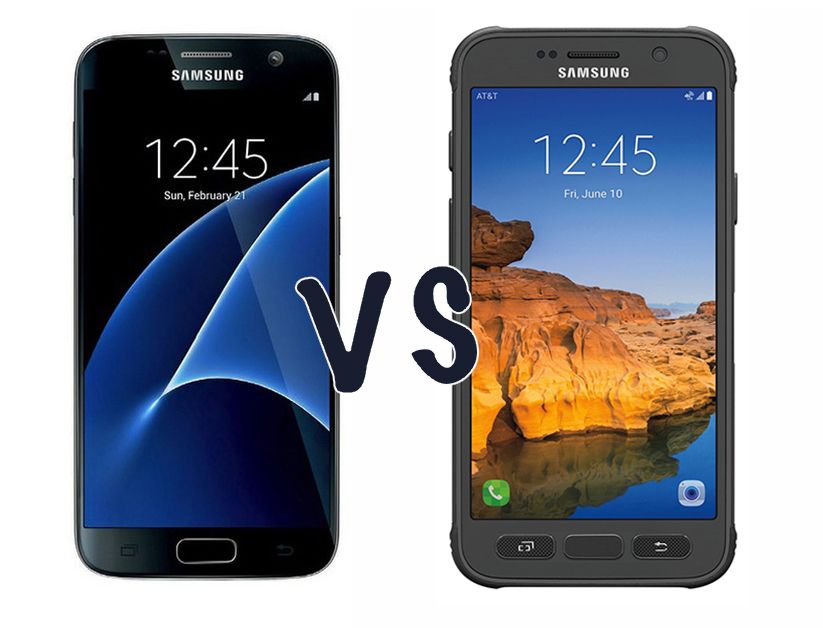If you're looking for a rugged phone, you have a new option through AT&T.
AT&T and Samsung partnered on a tougher version of the Galaxy S7, called the Galaxy S7 Active. Both companies have been working on these types of devices since the Galaxy S4 Active released in 2013. Keep reading to see how the Galaxy S7 Active differs from the Galaxy S7.
Samsung Galaxy S7 vs Galaxy S7 Active: Design
The Galaxy S7 Active - like the Galaxy S6 Active before it - is a tough version of Samsung's flagship smartphone. The screen is protected by a shatter resistant glass that should be able to withstand a drop or two. The rest of the handset, which is 9.9 mm thick and weighs 185g, is encased in a protective rubberised shell that will also help it to absorb the impact of knocks and drops.
Plus, it's IP68 certified for dust proofing and water resistantance over 1.5 meters and 30 minutes. It's also MIL-STD-810G certified against salt, dust, humidity, rain, vibration, solar radiation, transport (as well as thermal shock resistant). Oh, and in a first for a Galaxy Active, there's a fingerprint reader. The Galaxy S7 however looks very similar to the Galaxy S6 - only it sports a refined, slim, metal build.
It measures 142.4 x 69.9 x 7.9mm and weighs 152g. The quick-responding fingerprint sensor remains on the front, while the protruding rear camera lens is more subtle than the Galaxy S6's. The Galaxy S7 also introduced IP68-certification for dust and waterproofing, though it lacks MIL-STD-810G certification, making the Galaxy S7 more equipped to handle the outdoors.
Samsung Galaxy S7 vs Galaxy S7 Active: Display
The Galaxy S7 features a 5.1-inch Super AMOLED display with a QuadHD resolution. The Galaxy S7 Active has the same size display, type, and resolution. Keep in mind AMOLED technology tends to deliver brighter, more vibrant colours and deeper blacks when compared LCD screens.
Samsung Galaxy S7 vs Galaxy S7 Active: Camera
The camera department is where the Samsung Galaxy S7 line really shines. Samsung used a 12-megapixel rear snapper in the Galaxy s7 and increased the pixel size to 1.2um over 1.4um from the GalaxyS6. There is also a wider aperture on board at f/1.7 and dual pixel technology, which is also found in DSLRs, for quicker auto focusing. In a nutshell, the Galaxy S7 is all about offering better low light capture.
The front-facing camera is 5-megapixels and both perform very well. You point, you shoot and you get consistently good results. It offers fast, accurate auto-focusing and it's very easy to get good results with very little effort. The Galaxy S7 Active from what we can tell offers the same cameras, including features like phase detection autofocus, OIS, LED flash, and simultaneous 4K video.
Samsung Galaxy S7 vs Galaxy S7 Active: Hardware
Samsung offers two versions of the Galaxy S7 - depending on the region - with one offering a quad-core chip and the other an octa-core chip. The Snapdragon 820 will be the quad-core model, while the octa-core model will be Exynos 8 Octa. Samsung also offers 4GB of RAM along with 32GB and 64GB storage option. The Galaxy S7 comes with 3000mAh battery under the hood, charged via Micro-USB.
Also, microSD support was reintroduced for this device. As for the Galaxy S7 Active, it also has a Snapdragon 820 CPU with 4GB of RAM and 32GB of expandable storage. The Galaxy S7 Active stands out in the battery department, however. It'll come with a non-removable Li-Ion 4000 mAh battery. We're assuming that'll equally more play time, but we'll know for sure when we get the chance to review.
Samsung Galaxy S7 vs Galaxy S7 Active: Software
The Samsung Galaxy S7 launched on Android Marshmallow from the box. As you would expect, the company added its own software overlay, so it won't be a stock Android experience. You get the same familiar experience as you did with the Galaxy S6, but with the addition of a couple of features, such as the Games Launcher and Samsung Pay. The Galaxy S7 also comes with Samsung's security software called Knox.
Samsung has said that the Galaxy S7 Active will also come with Android Marshmallow. And with that you can expect the company's overlay too.
Samsung Galaxy S7 vs Galaxy S7 Active: Conclusion
The Samsung Galaxy S7 Active will be an AT&T exclusive and available from 10 June for around $26.50 per month on a standard Next plan, or $33.13 on a Next Every Year plan. It's nearly identical to the Galaxy S7 in terms of display, cameras, hardware, and software. It only really differs in design and ruggedness. If you're the outdoorsy type and a huge fan of the Galaxy S7 line, this is definitely the phone for you.
Similar to the new Galaxy S7 and S7 Edge flagships, the Galaxy S7 Active is IP68-certified and can be dunked in up to 5 feet of water for up to 30 minutes. It's also made to withstand dirt, sand, and drops from up to five feet - unlike the Galaxy S7. Other stand-out features are found in Samsung's newest Galaxy phones, however, such as a high-resolution 5.1-inch display, 12-megapixel rear camera and 5-megapixel front camera, and a Snapdragon 820 processor with 4GB of RAM. This year's Active does have a larger 4,000 mAh battery, though.
AT&T said that massive battery will provide over 32 hours of talk time and can fully charge in under two hours through fast charging. Apart from all that, the Galaxy S7 Active is the first Active to pack a fingerprint sensor. Keep in mind that, unlike other recent Galaxy S devices, the ruggedised design of the S7 Active means it will not work with Samsung's Gear VR virtual reality headset.

